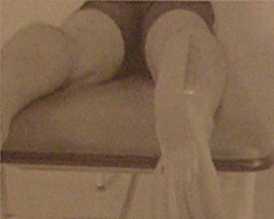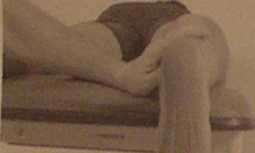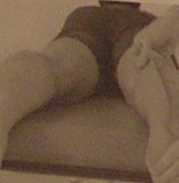P5140106
Achilles Tendonitis or Tenosynovitis
Achilles tendonitis is an inflammation to the Achilles tendon which is formed from the combination of the gastrocnemius and solcus muscles. The tendonitis is gcnerally łocated within the dis tai l/3rdof the Achilles tendon elose to its insertion into the calcaneous. The inflammation generally occurs from overuseactivity.
Achilles tendonitis will be treated with three Kinesio strips. The first strip will be a tendon correc-tion placed upon the Achilles' tendon. If the tendonitis is in the acute phase, the practiłionor may want to combine the tendon correction strip with the plantar fasda strip. Since the Achilles' tendon and the plantar fascia is a continual layer of connectivc tissue both may need to be treated to be most efliective. The second strip will be a Y strip for the gastrocnemius musełe. The third strip, optional, is placed upon the plantar surface of the foot to anchor the two preeious strips and aid in inereased tapc applica-tion length.

V

Begin by measuring a strip of Kinesio Tex Tape from the musculotendinous junction of the soleus and Achilles' tendon to the base of the metatarsal head on the plantar surface of the foot. Cut one end of the Kinesio strip with a fan techniąue for place-ment on the plantar aponeurosis. Tear the paper backing just past the end of the fan cut and place this on the heel of the patient. Remember to make surę the Kinesio strip is long enough to go approximately two inches beyond the musculotendinous junction.
Apply the Kinesio fan strip onto the base of the plantar surface. For review see plantar fasciitis techniąue.
w

Place the foot in dorsiflexion. With one hand hołd the Kinesio strip which has been placed on the calcaneous to limit any tension in this region. Apply a tendon correction techniąue, light to moderate, 25-50 % of available tension, to the Kinesio strip over the Achilles' tendon. At the musculotendinous junction decrease tension to very light or light, 15-25 % of available (paper off). Lay down the taił of the Kinesio strip with no tension.
Begin the second Kinesio Y strip slightly over the anterior aspect of the calcaneous.
Maintain the ankle and foot in a dorsi flexcd position. Apply the medial strip of the "Y" cut around the medial head of the gastrocnemius-an insertion to origin techniąue using very lig light, 15-25 % of available tension (paper off tensio Apply the lateral strip around the lateral hea o gastrocnemius with similar paper off tension.
If during the cvaluation of the Achilles ten on the practitioner determines there is muscle wea n » an origin to insertion application would be approP ate.
The third strip is place upon the plantar sur ace the foot to assist in the adhesion of the gastrocnenu Kinesio strip application. This strip is optional as 1 does not add to the effectiveness of the techniąue. does however assist in holding the gastrocnemius strip in place which may inerease the length of time the techniąue can be wom.
For this tape application the practitioner may select the water resistant Kinesio Tex Tape to limit t e detrimental affects of the high moisture concentra-tion in the foot region.
Completed Achilles' tendonitis Kinesio Techniąue
Photo on left: acute Achilles' tendonitis with plantar fasciitis included.
Photo on right: chronię or optional Achilles' tendonitis.
Wyszukiwarka
Podobne podstrony:
P5140084 Sciatica is an inflammation to the sciatic nerve which is generally associated with Iow bac
P5140103 Pes Anserinus Bursitis or Tendonitis Pes anserinus bursitis or tendonitis is an inflammatio
P5140109 Sever s Syndrome or Apophysitis of the Calcaneus Scver s syndrome is an inflammation of the
P5140120 Plantar Fasciitis Plantar Fasciitis is an inflammation of the plantar aponeurosis. Pain and
136 ZAąCdir* Hajn union may submit a disputc to the arbitration board, which is cqual ta gmng up thc
085 (8) ler Herc is an alternatine to the cul-and-sewflowers on page 66. Thisflower is madę i„ crocl
Temporary and PreUminary NMs: These are shown by (T) or (P) afier ihe ANM number and a reference to
An introduction to the graph theory A graph is a set of points, together with a set of arcs that con
P5140100 Meniscus of the Knee An iniury to the meniscus of the knee generaUy presents itself with pa
P5140113 Peroneal Tendon Subluxation A subluxation ofthe peroneus longus and brvvis tendon s cari re
skanuj0173 „Strategie mangement is a stream of decisions and actions which leads to the development
SNC00523 32 Thermography m human medicine Thermography or thermovision jn medfcme is based on the na
a "stereo seat." Sitting to the right or the left of center is no difTerent than the
Błock coding: When the błock coding is used, one or several check bits are added to the information
Gun Lobby Resistance łs 3 normally. Against any LiberaJ, Weird or Communist group, resistance is 10!
220 Haoirf Kalata A “request" of thc victim of an ofTencc to shorten his or ber pain. is unders
więcej podobnych podstron